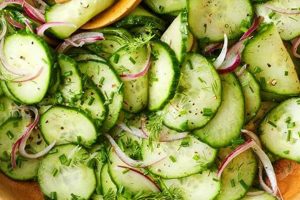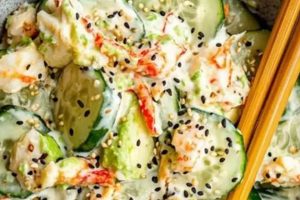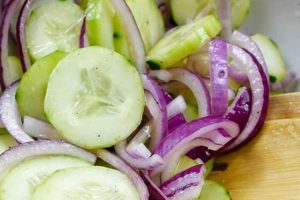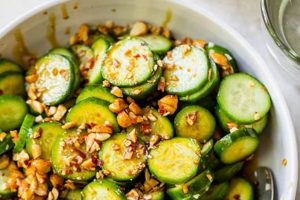A simple preparation of sliced cucumbers, often combined with other fresh ingredients like onions, herbs, and a light dressing, exemplifies this culinary concept. Variations exist, incorporating diverse flavor profiles from creamy dill to tangy vinegar or spicy Asian influences. A basic example might include thinly sliced cucumbers, red onion, rice vinegar, sugar, and a sprinkle of dill.
Refreshing and light, dishes fitting this description are ideal accompaniments to heavier meals, especially during warmer months. Their inherent simplicity makes them accessible to cooks of all skill levels, requiring minimal time and specialized equipment. Historically, cucumbers have been cultivated and consumed for millennia, and their incorporation into simple salads likely dates back centuries, offering a palatable way to enjoy this hydrating and nutrient-rich vegetable. Such preparations offer a low-calorie, vitamin-rich option for health-conscious individuals.
The following sections will explore specific variations, offering detailed instructions, ingredient lists, and tips for achieving optimal flavor and texture. Nutritional information and suggestions for ingredient substitutions will also be provided to cater to diverse dietary needs and preferences.
Tips for a Perfect Cucumber Salad
Achieving optimal flavor and texture in a simple cucumber salad relies on a few key techniques. Attention to detail, from ingredient selection to preparation methods, elevates this seemingly basic dish.
Tip 1: Salt and Drain Excess Moisture: Salting sliced cucumbers and allowing them to rest draws out excess water, preventing a watery salad. This step ensures a crisper texture and allows the dressing to adhere more effectively.
Tip 2: Choose the Right Cucumber: English cucumbers, with their thinner skin and fewer seeds, are ideal. For a traditional approach, standard cucumbers can be used, but peeling and seeding are recommended.
Tip 3: Thinly and Evenly Slice: Uniform slices ensure even flavor distribution and contribute to a pleasing aesthetic. A mandoline slicer or sharp knife achieves optimal results.
Tip 4: Balance Flavors: Acidity from vinegar or citrus juice should complement the sweetness of any added sugar. Herbs and spices further enhance the flavor profile.
Tip 5: Chill Before Serving: Chilling allows the flavors to meld and enhances the refreshing quality of the salad. Ideally, chill for at least 30 minutes before serving.
Tip 6: Don’t Overdress: A light dressing is key. Too much dressing can overwhelm the delicate flavor of the cucumbers. Add dressing just before serving to maintain crispness.
Tip 7: Consider Garnishes: Fresh herbs like dill, mint, or parsley, toasted sesame seeds, or a sprinkle of red pepper flakes elevate the visual appeal and add a final layer of flavor.
By following these tips, one can create a simple yet satisfying cucumber salad that showcases the fresh, clean flavors of its ingredients.
In conclusion, these guidelines provide a pathway to creating a consistently delicious and refreshing salad, demonstrating that simplicity can indeed be the key to culinary excellence.
1. Fresh Cucumbers
Fresh cucumbers are fundamental to a successful easy cucumber salad recipe. Their crisp texture and mild, refreshing flavor form the base of the dish. Using less-than-fresh cucumbers results in a compromised final product; the salad can become watery, mushy, and lack the desired vibrant taste. The quality of the cucumber directly impacts the overall quality of the salad. For instance, a salad made with wilted cucumbers will lack the desired crunch and have a less appealing, almost bitter, taste, whereas a salad made with firm, freshly picked cucumbers offers a delightful sensory experience.
Several factors contribute to cucumber freshness. These include proper storage (refrigeration is essential), selecting cucumbers that are firm and free from blemishes, and using them soon after purchase or harvest. Choosing the right variety also plays a role. English cucumbers, known for their thin skin and fewer seeds, are often preferred for salads due to their delicate texture. Failing to prioritize freshness can lead to a disappointing culinary outcome, underscoring the importance of this ingredient in a simple cucumber salad. One practical application of this understanding is to inspect cucumbers carefully before purchase, looking for signs of freshness such as firm texture and vibrant color.
The relationship between fresh cucumbers and a successful easy cucumber salad recipe is undeniable. Compromising on cucumber freshness negatively affects the texture, flavor, and overall appeal of the dish. Prioritizing fresh, high-quality cucumbers ensures a satisfying and refreshing culinary experience. Selecting the right cucumber variety and storing them properly are crucial steps in achieving the desired outcome. This emphasis on ingredient quality highlights the principle that even simple recipes benefit significantly from using the best possible components.
2. Thin Slicing
Thin slicing plays a crucial role in optimizing both the flavor and texture of easy cucumber salads. Thinly sliced cucumbers offer a delicate texture that contrasts pleasantly with other ingredients. The increased surface area facilitates more effective absorption of the dressing, ensuring each bite is infused with flavor. Conversely, thick slices can result in a less palatable, almost crunchy texture and uneven flavor distribution. Consider a salad with thinly sliced cucumbers dressed in a light vinaigrette: the delicate cucumber slices readily absorb the dressing, creating a harmonious blend of flavors. In contrast, thick cucumber slices in the same vinaigrette may taste bland and watery in the center, with the flavor concentrated only on the surface.
Beyond flavor enhancement, thin slicing contributes to the aesthetic appeal of the salad. Uniformly thin slices create a visually appealing presentation. This consistency enhances the dining experience, adding a touch of elegance to a simple dish. Imagine a salad with thinly sliced cucumbers arranged alongside other vibrant vegetables: the precision of the cuts elevates the visual presentation, making the salad more enticing. Furthermore, thin slicing allows for even layering and integration with other ingredients, creating a balanced and harmonious composition.
Achieving consistently thin slices requires appropriate tools and techniques. A sharp knife or mandoline slicer is essential. Practicing proper knife skills or utilizing a mandoline ensures uniformity and minimizes the risk of uneven or overly thick slices. This precision contributes significantly to the overall success of the easy cucumber salad, emphasizing the importance of this often-overlooked detail. Ultimately, the technique of thin slicing underscores the principle that careful attention to even seemingly minor details can significantly enhance the sensory and aesthetic qualities of a dish.
3. Simple dressing
Simple dressings play a pivotal role in easy cucumber salad recipes, enhancing the inherent flavors of the cucumbers and other components without overpowering their delicate nature. A complex or heavy dressing can mask the refreshing qualities of the cucumber, creating an imbalance in the overall flavor profile. The choice of dressing significantly impacts the final taste and perceived freshness of the salad. For example, a creamy ranch dressing, while flavorful, might overwhelm a cucumber salad, whereas a light vinaigrette complements the cucumbers’ subtle taste and crisp texture. The simplicity of the dressing allows the natural flavors of the fresh ingredients to shine through.
The effectiveness of a simple dressing often lies in its acidity. Vinegar-based dressings, particularly those utilizing rice vinegar, apple cider vinegar, or white wine vinegar, provide a bright, tangy counterpoint to the cucumber’s mild flavor. A touch of sweetness, often from a small amount of sugar or honey, balances the acidity and rounds out the flavor profile. The balance of these elements is crucial; too much acidity can make the salad overly tart, while excessive sweetness can mask the refreshing qualities. A classic example is a dressing made with rice vinegar, a touch of sugar, and a pinch of salt, which enhances the cucumber’s flavor without overpowering it. This balance allows the inherent freshness of the salad to remain prominent.
Understanding the impact of dressing choice on an easy cucumber salad allows for informed culinary decisions. Recipes often call for simple dressings precisely because they complement, rather than compete with, the primary ingredient. The balance of acidity and sweetness, combined with minimal ingredients, allows the fresh, crisp flavor of the cucumber to take center stage. This principle extends to other simple salad preparations where delicate flavors benefit from equally simple enhancements. Recognizing this connection enables cooks to create balanced and refreshing dishes that highlight the natural qualities of fresh ingredients. This understanding ultimately leads to a more satisfying and enjoyable culinary experience.
4. Minimal Ingredients
Minimal ingredients are a defining characteristic of easy cucumber salad recipes. The inherent simplicity of these recipes stems directly from the limited number of components. This characteristic contributes to both ease of preparation and the preservation of the cucumber’s delicate flavor profile. An overabundance of ingredients can mask the refreshing qualities of the cucumber and complicate the preparation process. A classic example is a cucumber salad consisting solely of thinly sliced cucumbers, red onion, a simple vinegar-based dressing, and a sprinkle of fresh dill. The restrained ingredient list allows the fresh flavors to shine through.
The emphasis on minimal ingredients offers practical advantages. Reduced shopping lists, shorter preparation times, and simplified cooking processes are direct results. This efficiency makes easy cucumber salads an accessible and appealing option for cooks of all skill levels. Consider the difference between a simple cucumber salad and a more complex salad involving numerous ingredients and elaborate preparation steps: the former requires significantly less time and effort, making it a practical choice for everyday meals. This practicality enhances the appeal of these recipes for busy individuals or those seeking quick and healthy meal options.
Furthermore, the principle of minimal ingredients allows the inherent qualities of fresh produce to take center stage. Rather than masking the cucumber’s flavor with complex sauces or numerous competing ingredients, a simple preparation highlights its natural freshness and crisp texture. This focus on quality ingredients underscores a key principle of culinary art: simplicity often allows the true flavors of fresh, high-quality ingredients to shine through. The success of easy cucumber salad recipes demonstrates that culinary complexity is not a prerequisite for delicious and satisfying results. This understanding has practical implications for recipe development and ingredient selection, emphasizing the importance of quality over quantity.
5. Quick Preparation
Quick preparation is intrinsically linked to the concept of an easy cucumber salad recipe. The minimal processing required for cucumberstypically slicing and perhaps peelingcontributes significantly to the speed of assembly. This characteristic distinguishes cucumber salads from more labor-intensive salad preparations involving multiple chopping, cooking, or processing steps. The time investment for a basic cucumber salad is minimal, often requiring mere minutes from start to finish. This efficiency makes it a practical choice for weeknight meals, last-minute additions to potlucks, or a refreshing side dish when time is limited. Consider, for example, the contrast between preparing a cucumber salad and a potato salad: the latter involves boiling and cooling potatoes, chopping other vegetables, and mixing a more complex dressing, significantly extending the preparation time.
The speed of preparation is further enhanced by the simplicity of the dressings typically used in these salads. Often consisting of a few readily available pantry staples like vinegar, oil, and seasonings, the dressings require no cooking or elaborate mixing. This streamlined approach contributes to the overall efficiency of the recipe. For instance, a simple vinaigrette can be whisked together in seconds, whereas a more complex dressing, like a Caesar dressing, may involve multiple ingredients and steps, adding to the overall preparation time. This ease of dressing preparation further solidifies the quick nature of cucumber salads.
The practical implications of rapid preparation are significant. Cucumber salads become an accessible option even for individuals with limited time or culinary experience. Their ease of assembly encourages healthy eating habits by providing a quick and nutritious side dish option. This accessibility broadens the appeal of these recipes, making them a versatile and convenient choice for various occasions and lifestyles. Ultimately, the quick preparation associated with easy cucumber salad recipes underscores their practicality and contributes to their widespread popularity as a refreshing and readily available culinary option.
6. Versatile Variations
The adaptability of the basic cucumber salad framework allows for extensive customization, transforming a simple concept into a versatile culinary canvas. “Versatile variations” are integral to the enduring appeal of easy cucumber salad recipes, offering a range of flavor profiles and ingredient combinations to suit diverse palates and culinary contexts. This adaptability stems from the cucumber’s neutral flavor profile, which readily complements a wide array of other ingredients.
- Cultural Adaptations
Cucumber salads transcend geographical boundaries, appearing in various cuisines with distinct flavor profiles. Asian-inspired variations might incorporate sesame oil, soy sauce, rice vinegar, and ginger, while Mediterranean versions often include feta cheese, olives, and lemon juice. These cultural adaptations demonstrate the cucumber’s global culinary relevance and its adaptability to diverse flavor palettes. A Greek cucumber salad, for example, differs significantly from a Korean cucumber salad, showcasing the cucumber’s versatility in adapting to regional ingredients and culinary traditions.
- Ingredient Swaps and Additions
The basic formula of sliced cucumbers and a light dressing provides a foundation for endless experimentation. Incorporating different herbs, such as dill, mint, or parsley, introduces distinct aromatic notes. Adding other vegetables, like tomatoes, onions, or bell peppers, enhances textural and flavor complexity. Swapping vinegar typesfor example, using apple cider vinegar instead of rice vinegarcreates subtle yet noticeable shifts in the overall flavor profile. These ingredient swaps and additions highlight the customizable nature of the easy cucumber salad, allowing cooks to personalize the dish according to preference and ingredient availability.
- Sweet and Savory Profiles
Cucumber salads can easily transition between sweet and savory profiles through subtle ingredient adjustments. Adding a touch of sugar or honey to the dressing creates a subtly sweet and tangy flavor profile, often found in Asian-inspired variations. Conversely, omitting sweeteners and emphasizing herbs and spices results in a more savory dish, well-suited as a side to grilled meats or fish. This flexibility demonstrates the cucumber’s ability to anchor both sweet and savory flavor combinations, expanding its culinary applications.
- Textural Contrasts
While thinly sliced cucumbers are standard, variations in slicing techniques create interesting textural contrasts. Using a crinkle cutter or grating cucumbers adds a different dimension to the salad’s mouthfeel. Incorporating ingredients with contrasting textures, such as toasted nuts or seeds, further enhances the sensory experience. These textural variations move beyond the basic thinly sliced preparation, adding layers of complexity to an otherwise simple dish. A cucumber salad with toasted sesame seeds, for example, offers a pleasant textural contrast to the smooth cucumbers.
These versatile variations transform the easy cucumber salad from a basic side dish into a dynamic culinary creation. The cucumber’s adaptability allows for a wide range of flavor profiles, ingredient combinations, and textural contrasts, ensuring its continued relevance in diverse culinary contexts. The simplicity of the basic recipe provides a foundation for endless experimentation and customization, making it a perpetually appealing option for both novice and experienced cooks.
Frequently Asked Questions
This section addresses common inquiries regarding the preparation and variations of easy cucumber salads.
Question 1: How can excess moisture in cucumber salad be prevented?
Salting sliced cucumbers and allowing them to drain for approximately 15-20 minutes before incorporating them into the salad draws out excess water. This step ensures a crisper texture and prevents a watery final product.
Question 2: What type of cucumber is best suited for these salads?
English cucumbers, due to their thinner skin and fewer seeds, are often preferred. However, standard cucumbers can be used with peeling and seeding recommended to minimize water content and maximize crispness.
Question 3: What are some recommended dressings for a simple cucumber salad?
Light vinaigrettes are ideal. Rice vinegar, apple cider vinegar, or white wine vinegar combined with a touch of oil, sweetener (such as sugar or honey), and salt create balanced and flavorful dressings. Variations can include the addition of herbs, spices, or a touch of mustard.
Question 4: How long can cucumber salad be stored in the refrigerator?
Ideally, cucumber salad is best consumed fresh. However, it can be stored in an airtight container in the refrigerator for up to two days. The texture may soften slightly over time.
Question 5: Can cucumber salad be prepared in advance for events?
While best served fresh, components can be prepared in advance. Store sliced cucumbers and dressing separately and combine just before serving to maintain optimal texture and prevent the salad from becoming watery.
Question 6: How can one adapt cucumber salad to accommodate dietary restrictions?
Substitutions can easily be made to accommodate dietary needs. For vegan diets, ensure the dressing uses a plant-based sweetener like maple syrup or agave nectar. Gluten-free variations typically require no adjustments as the basic ingredients are naturally gluten-free.
Understanding these frequently asked questions facilitates successful preparation and enjoyment of various easy cucumber salad recipes, offering insights into best practices for achieving optimal flavor, texture, and storage.
This information provides a foundational understanding for preparing delicious and refreshing cucumber salads. Experimentation with different variations and flavor profiles is encouraged.
Cucumber Salad Easy Recipe
Exploration of the “cucumber salad easy recipe” concept reveals its essence lies in simplicity and adaptability. Fresh, thinly sliced cucumbers, complemented by a light dressing and minimal ingredients, create a refreshing dish requiring minimal preparation time. The versatility of this foundation allows for extensive customization, accommodating diverse flavor preferences through ingredient additions, cultural adaptations, and textural variations. Emphasis on ingredient quality, particularly cucumber freshness, significantly impacts the final product’s sensory experience. Proper slicing techniques and balanced dressings further elevate this seemingly simple preparation.
Culinary exploration often reveals complexity masked by simplicity. The “cucumber salad easy recipe,” while straightforward in execution, offers a platform for creativity and culinary expression. Its accessibility encourages experimentation, empowering individuals to create personalized variations tailored to specific tastes and dietary needs. This adaptability ensures its continued relevance in a constantly evolving culinary landscape. The enduring appeal of this simple dish underscores the power of fresh ingredients and thoughtful preparation in creating a satisfying and refreshing culinary experience.






